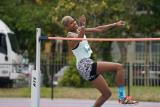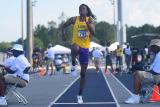Folders |
Time is Running Out For U.S. Olympic Hopefuls in the Men's 1,500Published by
Many In Men's 1,500 Still Need To Run Fast Or Risk Being Passed Over For Olympics By Mark Wang for DyeStat Photo by Chuck Utash Over the last decade and a half the U.S. has been known for having some of the strongest mid-distance talent in the world. That depth and strength showed up in Rio Games five years ago when Matthew Centrowitz won the United States' first gold medal in the 1,500 meters in 104 years. Fast forward five years and we’re a month away from the Olympic Trials in Eugene and things aren’t looking great for U.S. metric milers. So far only seven guys have a chance to go to Tokyo on either time or ranking. There are three guys based on rankings: Johnny Gregorek, Ben Blankenship and Sam Prakel. And four on time: Defending champ Centrowitz, Craig Engels, Josh Thompson and Notre Dame's Yared Nuguse. With just a few weeks to go and a few more fast meets coming up on the schedule, this could set up some really fast prelims June 24 and semifinals June 25 at Hayward Field. Now you may be thinking: “But hold on we’ve heard a lot of guys have gotten qualifiers.” That's only partly true. A lot have Olympic Trials qualifiers. Meaning they have a spot at the trials in Eugene, but unless they get the Olympic standard or climb the world rankings within the next month they won’t have a chance to get to Tokyo. So this begs the question: what’s happened and why are so many guys missing the Olympic standard? For starters: it’s hard. There’s no way around it, 3:35.00 is not an easy time to run. Originally it was a second slower (3:36.00) but then after the pandemic it was adjusted. The U.S. Olympic Trials Standard is 3:37.50, also not an easy time to run, and a number of Americans have run that, but not the tougher standard. What else could be contributing to this downturn in elite milers getting that standard? There are a number of factors to point to. Mostly under/over racing, lost opportunities, and with that, limited opportunities when they came back from the pandemic. The first is over-racing or under-racing. Collegians fall more into the over-racing category. For the most elite college guys, such as Oregon's Cole Hocker for instance, the racing begins in January and goes all the way through June at the least, and later if they qualify for international meets. This contributes to hitting the "wall," or burnout, later in the season, which is when guys usually go for the standards. Most pros won’t start racing outdoors until May and unless they run indoors this is when they open things up. And while they can be in shape, that doesn’t always translate to success on race day. Under-racing prevents training the legs to shift gears quickly in competition. Another reason for being under-raced is due to the widespread cancellations that took place in 2020. Everything had shut down in early March, which was right at the end of indoor season and the beginning of outdoors. With the outdoor season mostly lost, many opportunities to get the standard evaporated. The opportunities to race in 2020, even when the season got up and running, were still limited. Teams ran intrasquad meets and some meets were held regionally. The Big Friendly Meets put on in Oregon were every few weeks and the inaugural Sound Running event was in July. There were some good performances in those meets, just not many in in the men's 1,500. This all sets up to make the Trials very interesting. With not many big meets left and less than a month to go before the all-important Trials, the standings will most likely stay the same. Many will feel like they need to chase the standard or face the prospect of a top-three finish at the Trials and then not have the credentials to be able to compete in Tokyo. That could lead to fast qualifying races in the first two rounds before the June 27 final, but could leave guys gassed to challenge the seven guys who have an easier route to get there and are already safely in possession of the standard. It also shows that while the U.S. has a lot of fast milers, they still have a steep hill to climb if they want to make it to Tokyo. So while we may be sending at least one guy into the final at the Olympic Stadium, the U.S. doesn’t currently have the depth it usually shows in the 1,500. More news |







